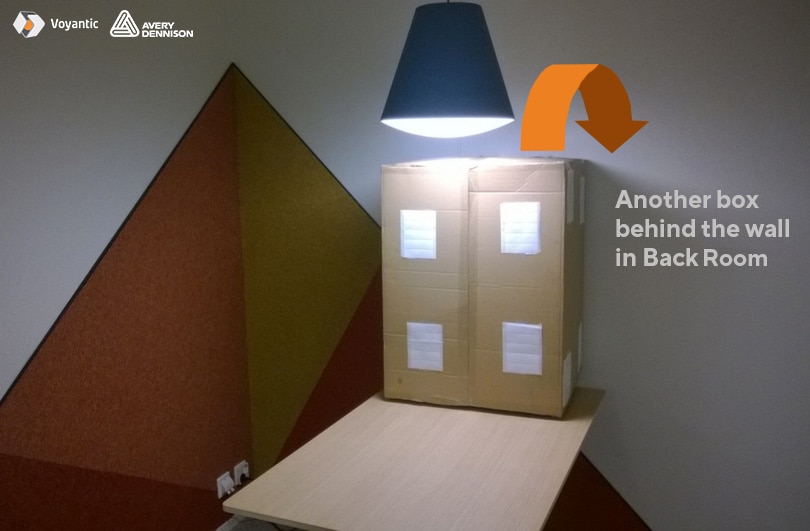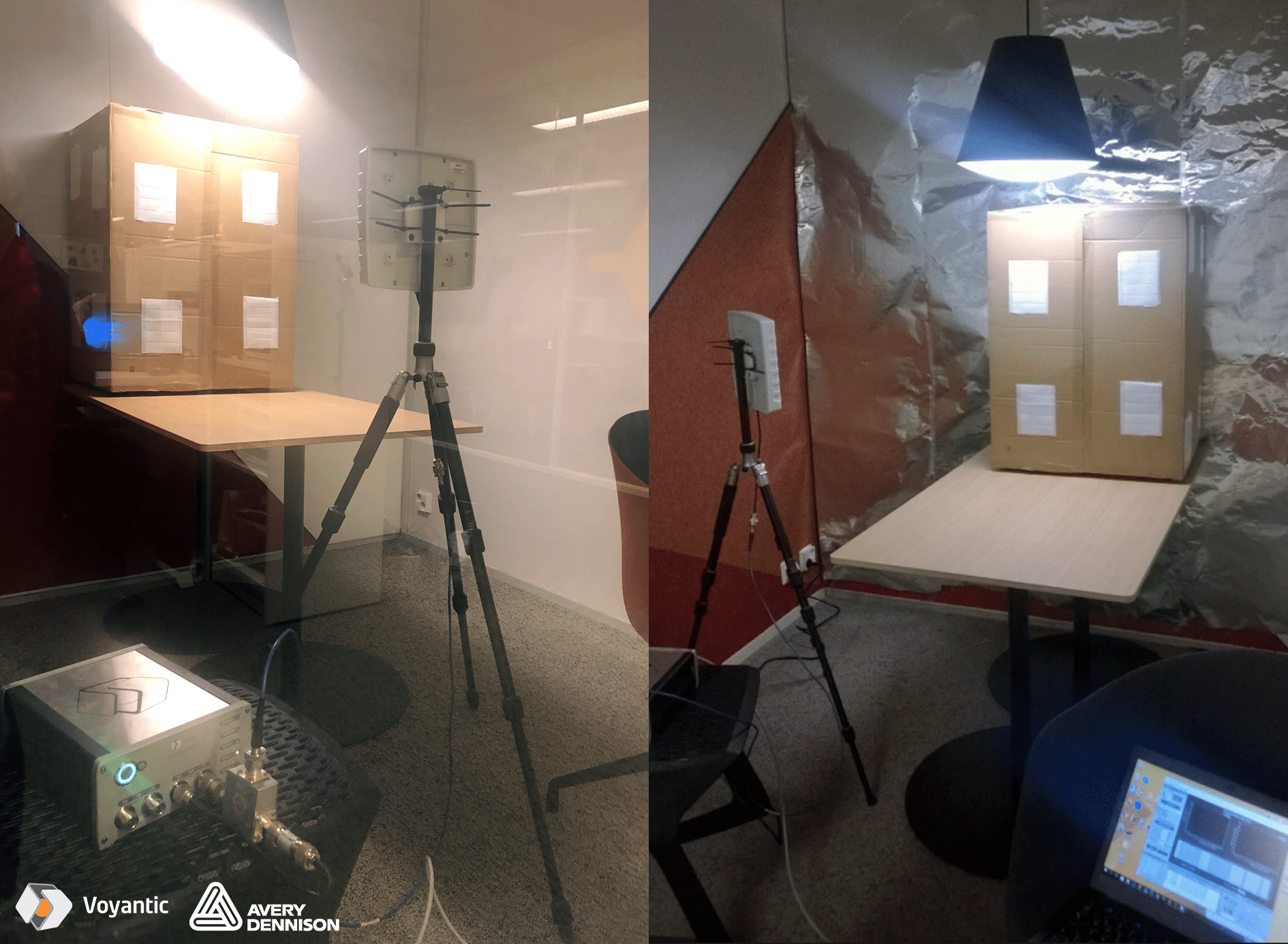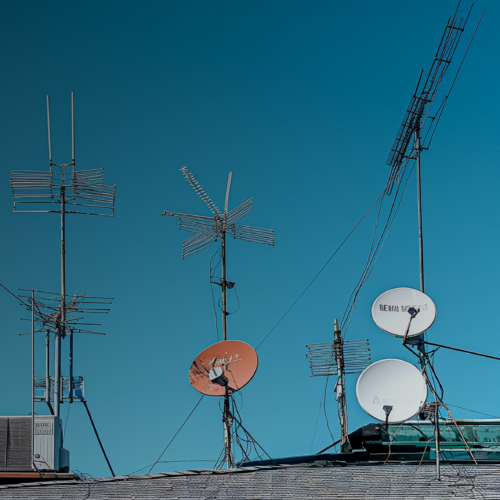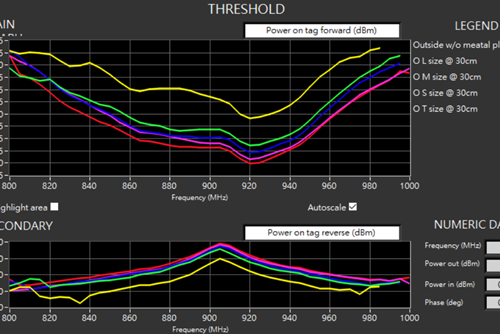At RFID&WIoT Tomorrow 2019, Erik van Noort from Avery Dennison stopped by a Voyantic booth. He introduced a recently launched ShieldSense™ RFID blocking material. The material is for reader zoning and aimed to help system integrators in building better RAIN RFID systems.
After sharing some ideas, we decided to write an article explaining the reader zoning and how to use Voyantic Tagformance to check not only if the zoning works, but how well the zoning works. In this piece, we introduce the ShieldSense™ material with the Tagformance test results.
What Is Reader Zoning?
Reader zoning is a common challenge when building RAIN RFID systems. You want to scan tags in one area, but don’t want to read tags from another area nearby. For example, at a loading dock, it is essential to know that the item passes a specific gate and goes to the correct truck, and not to the next truck a few feet away.

Reader Zoning challenges
- An apparel store has stock at the backroom
- Every item in stock should be represented at the shop floor
- With RAIN RFID it is possible to count and identify every item at the backroom and the shop floor, with a few minutes scan – quick enough to be done several times a day
- The system can then generate an alert if an item type is not represented on the shop floor
- Having each item represented on the shop floor is critical. If an item is forgotten, it would never be sold during the season and would have to be either heavily discounted afterward as the last season item, or even wasted
Reader Zoning – Test Without ShieldSense™
Conventional methods for reader zoning are
- selecting reader antennas with different reading angles
- planning reader placement
- adjusting reader power levels
- using the RSSI filter to prevent stray reads
- applying RF shielding material aka RF blocking material
For testing the zoning challenge, I designed a simple test environment in our office. In one of our meeting rooms (“Front Room”), I had 100 tags placed on all sides of a cardboard box. In the next room (“Back Room”), behind a wall, there were another 100 tags placed on a similar box.

My goal was to find reader settings that would allow the inventory of the 100 tags in the Front Room without reading any tags from the Back Room. In the test, I used an antenna placed on different locations and orientations in the Front Room. I used the Tagformance population analysis as a test tool. A combination of several test positions would correspond with someone doing an inventory count with a handheld RFID reader.
Results Without RF Blocking Material
There was no antenna placement and orientation in the Front Room with which all of the tags in the Front Room could be read. In typical good positions, 85% – 95% of the tags were scanned. One apparent challenge was that the light wall between the Front Room and the Back Room did not block the RF signal. With antenna orientations that gave the best read results in the Front Room, a good number of tags from the Back Room were also found. In some antenna positions, more tags were found from the Back Room than from the Front Room.


No antenna placement would give a decent amount of readings from the Front Room without giving any readings from the Back Room


Even if 100% reading was not achieved from any single antenna position, a 100% read rate from the Front Room was achieved when two antenna positions were combined. In practice, a 100% read rate would be easy to achieve by a simple handheld reader sweep. But, the combination of two positions gave over 90% rate also from the Back Room.
No power level cut would enable efficient zoning. At any power level with which tags are found from the Front Room, some tags are also found from the Back Room.
There is no difference at backscatter signal strengths from tags in the Front Room and tags in the Back Room. RSSI filter would not be efficient for reader zoning in this scenario.
After the first tests, it was apparent that the task is hard. There was no reading angle where power adjustment or RSSI filter could separate the items. In the test scenario, antenna placement, adjusting reader power, RSSI filter, or any combination of those would not solve the zoning issue.
Reader Zoning – Test With ShieldSense™
For the delight of fellow Voyanticians, I wallpapered part of the Front Room with Avery Dennison’s ShieldSense™ material. After shaking of the numerous “do they make foil hats of that” comments, I did the second part of the testing. I again placed antenna to different positions and tried to find an antenna position where zoning would work. In this test, I also used the Voyantic High-Power kit to boost radiated power beyond normal power levels, up to 39 dB ERP radiated power (antenna in the test had about 8dB gain).

with test equipment)
Results With RF Blocking Material
The positive effect of ShieldSense™ was apparent immediately. In most antenna positions tags from Back Room were not found
It was also noticed that in the original test scenario, some tags were leaning against the wall, and after applying ShieldSense™, those tags were leaning against the metal surface, making the tags non-readable.



There were still read angles that gave some readings from the Back Room when the power level was high enough. Most likely, the read is from reflections, the Front Room was only partially shielded, and in some antenna orientations, the signals have some reflecting paths even if the direct paths are blocked.

When the power levels and backscatter signal strengths are analyzed, efficient zoning parameters can be found. Using 30dB radiated power and applying -65dBm RSSI filter with a handheld reader
- would give 5dB safety margin before read rate would drop to below 100%
- would give 5dB safety margin before tags in the Back Room would wake up
- about 8dB margin in RSSI until reader would accept the response from Back Room
These safety margins are likely well sufficient for ensuring reliable system performance also in the long run.
I am also convinced that expanding the ShieldSense™ coverage a bit around the corner instead covering just one wall, and applying it permanently instead of the temporary mount I used, the safety margins would increase by some dBs
With ShieldSense™ it is easy to find reader power levels and RSSI filter values with which zoning works, and safety margins are good for getting reliable reads as well as for avoiding stray readings.
All blog posts

